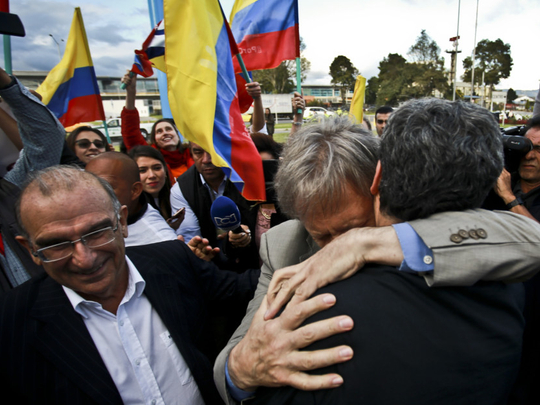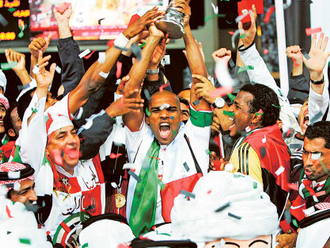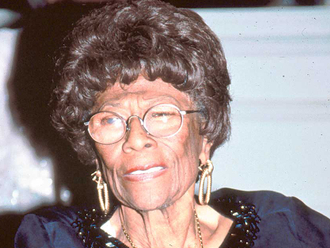
In the coming weeks, Colombians will be asked to cast a vote like none other in the country’s history. The sole question on the ballot will be whether Latin America’s third most populous nation should ratify a historic peace agreement to end the longest-running guerrilla insurgency in the Western Hemisphere.
It seems like a silly question: After a conflict that has raged for half a century, taken 220,000 lives and uprooted more than six million people, what’s to decide?
And yet, it’s a measure of the parlous mood in Latin America’s most conflicted nation that the fate of the Colombian peace process is still anyone’s guess.
After all, the talks between the government of President Juan Manuel Santos and leaders of the Revolutionary Armed Forces of Colombia (or Farc) have dragged on since November 2012, suffered multiple setbacks and left some vexing details hanging. One sticking point is that despite their tacit agreement to lay down weapons, the Farc will not be fully disawrmed by the time Colombians vote on the referendum, which is scheduled for early October.
The end of the insurgency doesn’t mean drug trafficking will stop, nor will it compel holdout groups, such as the estimated 2,000-strong National Liberation Army (ELN), to cease their hostilities.
While no one imagined that ending the longest-running war in the Americas would be simple, Colombians would be forgiven for wondering what comes next and who’ll pay the price. In many ways, the 297-page agreement unveiled in Havana last Wednesday is just the beginning of an even trickier moment for the Andean nation of nearly 50 million people.
Colombian lawmakers must still sign off on the plan. Likewise, the guerrilla leaders will have to consult their top guns at an undisclosed location in the Colombian jungle.
Santos doggedly insists that once the accord is finally signed, Colombians will vote “overwhelmingly” to support peace. He has argued, convincingly, that war’s end will encourage investment, bringing a “peace dividend” of up to 1.5 per cent annual growth. (Of course, that will be at least partly offset by the estimated $16.8 billion, or Dh61.79 billion, Colombia will spend rebuilding the country.) That’s one reason why two-thirds of Colombia’s small businesses, which generate 67 per cent of the country’s jobs, back the peace plan.
An August poll by Invamer backed this claim, showing that two-thirds of those surveyed planned to vote for the deal. (Another poll showed Colombians more evenly divided.) But that’s not the whole story.
Invamer also reported that few Colombians believed that peace will spread wealth in the countryside (37 per cent), reduce ideologically motivated violence (22 per cent), impel the Farc to compensate their victims (20 per cent) or lead ex-combatants to fight drug trafficking (17 per cent).
There’s reason for scepticism. Start with the fact that Santos’s peace initiative was seen by many Colombians not just as a gamble, but an act of political sedition.
After all, Santos’s predecessor Alvaro Uribe had waged an outright war against the Farc, vastly reducing their numbers and firepower — with Santos as his defence minister. Uribe left office with soaring ratings, and his protege, a political novice, swept into power on a hero’s coattails. By reversing course and reaching out to the Farc, Santos not only scrapped Uribe’s hawkish line but also turned his former mentor into his fiercest rival, who still commands a respectable following.
What’s clear now is that the fate of Colombian peace turns less on the nuances of the proposal than it does on the battle between the country’s political brokers, which is raging.
Though war-weary Colombians gave Santos the benefit of doubt, re-electing him over a hardliner in 2014, the arduous talks and relentless attacks by ‘Uribistas’ have taken their toll. After Santos’ six years in office, only one in four Colombians approve of his government.
A president’s error
Santos’s error was not trying to woo the enemy into a deal but in misreading the country’s misgivings over the terms of peace. After half a century of bloody insurgency and failed truces, loathing for the Farc runs deep in Colombia, and the government’s concessions to former combatants risk seeming overly generous.
Critics are especially galled by the provisions that allow penitent guerrillas to avoid jail and even run for political office if they come clean.
“Colombians clearly wanted an end to war, but not necessarily this agreement,” Michael Shifter, president of the Inter-American Dialogue, a policy research centre, told me.
“They wonder if the government has given up too much to a group already on the run and with little political support.”
With an unprecedented truce at hand, Santos hasn’t flinched.
Only now he must not just bring home the peace but also convince his compatriots that it wasn’t surrender.
— Bloomberg
Mac Margolis is a Bloomberg View contributor based in Rio de Janeiro.








